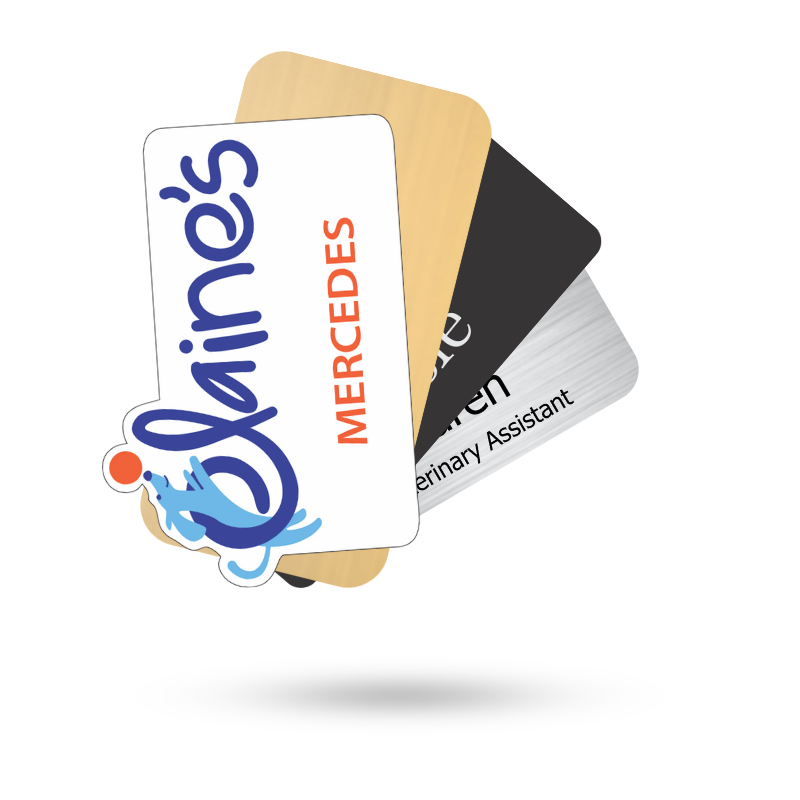Role-Based Color-Coding Name Badges
Color Coded Name Tag Benefits

In today's dynamic workplace, effective visual communication is more important than ever. One trend that's revolutionizing how organizations manage and identify their personnel is role-based color coding for name badges. This simple yet powerful system is transforming how employees, visitors, and stakeholders navigate modern workplaces.
The Psychology Behind Color Coding Name Tags
Color coding isn't just about aesthetics. It's rooted in cognitive psychology. Our brains process colors faster than text, making color-coded badges an efficient way to convey information at a glance. Studies have shown that color recognition happens up to 60% faster than reading text, making it an invaluable tool in fast-paced environments where quick identification is crucial.
Benefits of Role-Based Color-Coding Name Badges
Security Enhancement: Color coding provides an immediate visual cue about who should be where. Security personnel can quickly identify if someone is in an unauthorized area simply by noticing their badge color, enabling faster response times to potential security breaches.
Improved Customer Experience: In customer-facing environments, color coding helps clients quickly identify the right person to approach. For instance, a retail store might use blue badges for sales associates, green for department managers, and purple for technical support staff.
Streamlined Communication: When employees can instantly recognize colleagues' roles, interdepartmental communication becomes more efficient. This is particularly valuable in large organizations where not everyone knows each other personally.
Emergency Response: During emergencies, color coding helps first responders quickly identify key personnel such as floor wardens, first aid officers, or emergency response team members.
Implementing an Effective Color-Coding System
Successful implementation of a color-coded badge system requires careful planning. You’ll also want to consider several factors:
Consistency: Choose colors that are distinctly different from each other to avoid confusion. Consider using color psychology – for example, red for security personnel can invoke authority, while green might represent customer service or environmental roles.
Accessibility: Ensure your color choices are visible under different lighting conditions and consider colorblind employees when selecting your palette. Including patterns or symbols alongside colors can help make the system more inclusive.
Simplicity: Limit the number of colors used to prevent overwhelming people. Most successful systems use 5-7 core colors, with additional identifiers like stripes or borders for subspecialties.
Documentation: Create clear guidelines documenting what each color represents and ensure this information is readily available to all stakeholders.
Industries That Benefit from Role-Based Name Badge Color Coding
While the advantages of a color-coded badge system are universal, some industries see particularly impactful benefits:
Healthcare
In hospitals or clinics, where roles vary widely, color-coded badges help patients and staff identify each other quickly. Doctors might wear white badges, nurses green, and administrative staff blue. This system reduces confusion and ensures that patients know who to approach for specific needs.
Events and Conferences
For large gatherings, role-based badges are a lifesaver. Speakers, organizers, vendors, and attendees can each have a unique badge color. This makes it easier for attendees to connect with the right people and enhances the overall experience.
Education
Schools and universities can use color-coded badges to distinguish between faculty, staff, visitors, and students. This adds an extra layer of security while fostering better communication within the campus.
Retail and Hospitality
For businesses that rely on customer service, color-coded badges help customers identify who they need to speak to. For example, in a hotel, front desk staff might wear blue badges, while housekeeping wears green.
Tips for Designing Effective Role-Based Color-Coded Name Badges
If you’re considering implementing a color-coded name badge system, here are a few key tips to ensure it works smoothly:
Choose Distinct and Intuitive Colors
Select colors that are easily distinguishable from one another. Avoid shades that are too similar, such as light green and teal, as they can cause confusion.
Include Clear Role Titles
In addition to color coding, ensure the role or department is clearly printed on the badge. For example, a badge might say "Event Organizer" in bold text alongside its color.
Incorporate Your Branding
Custom badges are an opportunity to reinforce your brand identity. Incorporate your
company logo and colors in a subtle way that doesn’t interfere with the color-coded system.
Use High-Quality Materials
Since badges are often exposed to wear and tear, opt for durable materials like laminated cards or sturdy plastic. This ensures the colors stay vibrant and readable over time.
Provide Training or Guidance
Introduce the color-coded system with a quick overview or guide. Ensure all employees and stakeholders understand what each color represents and how to use the system effectively.
Future Trends
The future of role-based color coding is evolving with technology. Smart badges might change color based on role changes or temporary assignments. Some organizations are experimenting with subtle LED indicators that can change colors based on current responsibilities or availability status.
Role-based color coding in name badges is more than just a trend – it's a practical solution for modern workplace organization. When implemented thoughtfully, it can significantly improve security, communication, and operational efficiency. As workplaces continue to evolve, color coding systems will likely become even more sophisticated, potentially integrating with digital systems to create smart, adaptive identification solutions that meet the changing needs of organizations.
Share Article
Categories







